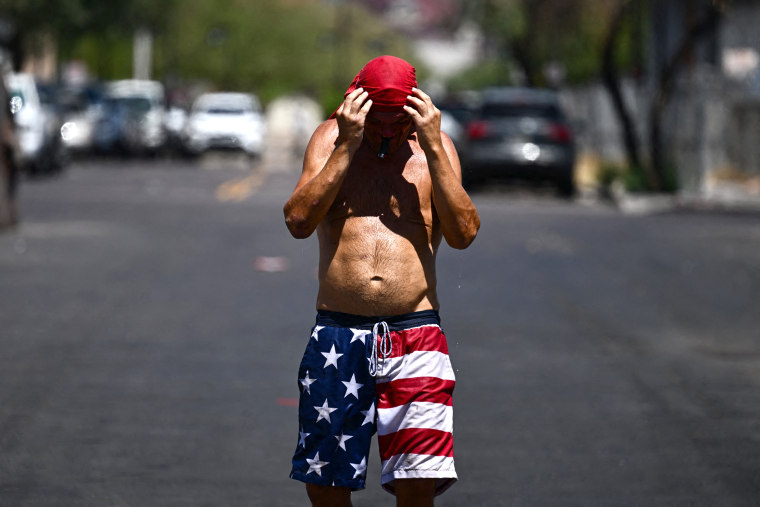As temperatures soar in the Southwest, doctors say heat-related illnesses are not the only health hazards filling up emergency rooms. Cases of contact burns — some as severe as second- or third-degree burns — have significantly increased during this heat wave.
Emergency workers in Arizona and Nevada reported an uptick in cases of contact burns as temperatures spiked into the triple digits, and have remained high for weeks on end.
The burns typically occur when people fall or pass out on sun-scorched pavement and other hot surfaces. During intense heat waves, as has been unfolding across the Southwest, even being in contact with these surfaces for short periods of time can do serious damage, said Dr. Kara Geren, an emergency medicine physician at Valleywise Health in Phoenix.
“The burns can be very severe and disfiguring to the point where you have to have what’s called a skin graft, where they take skin from other parts of your body and kind of cover it up,” she said.
As with heat-related illnesses, children, older adults, individuals who work outdoors and people who are homeless tend to be most at risk of burns, she said.
Geren said two burn patients were admitted earlier this week right at the end of her shift — one who fell and was unable to get up and another who had a suspected seizure and was found on the ground with third-degree burns.
At least 10 people were treated for contact burns at Valleywise Health last week, according to a hospital spokesperson. Geren said she expects more to come as the heat wave persists into next week.
“The burn unit is very full,” she said. “It just keeps going.”
Contact burns occur every year when temperatures spike in the summer, but doctors said people should be extra cautious during severe heat waves.
Last year, the Arizona Burn Center treated 85 cases of heat-related burns from June through August, according to a report released last month by Valleywise Health. Some of those patients were admitted with body temperatures more than 108 degrees Fahrenheit, and seven individuals died from their injuries, the hospital said.
Almost two weeks ago, Christopher Malcolm, a 73-year-old Air Force veteran, suffered third-degree burns while waiting for a bus in Las Vegas. He said it was about 110 F out that day and he started to feel overheated, so he sat down on the sidewalk.
“I guess the pavement was hot enough so that it burned, although I was wearing blue jeans,” he said, adding that he sat on the pavement for about 40 minutes and did not realize the severity of his injury.
Dr. Syed Saquib, a trauma burn surgeon at University Medical Center in Las Vegas, said superhot pavement can cause serious injuries in a short time.
“When the temperature in our valley gets above 100 degrees, 110 degrees, the pavement depending on the surface can heat up to 160 to 170 degrees Fahrenheit,” he said, “And all it takes is a couple of seconds of your skin being exposed to that to create a second-degree burn.”
Last weekend, as temperatures peaked across the Southwest, officials at the Las Vegas office of the National Weather Service measured temperatures on different surfaces when the ambient air temperature was 115 F, and found huge differences between rock, concrete and asphalt in the shade and in the sun.
For instance, a rocky sidewalk in the shade was 115.1 F, but was 155.8 F in the sun. While shaded asphalt registered as 128.4 F, that same type of surface in the sun was almost 158 F.
Malcom was scheduled to undergo surgery last Friday. He said this kind of injury was completely unexpected.
“I’ve dealt with heat before,” he said. “I lived in the Philippines for about seven years. Never had any problems with heat. I’ve been here about 22 or 23 years, never had any problems with heat until about 12 days ago.”
Still, Malcolm said, he’s grateful he did not collapse on the sidewalk or suffer even more serious injuries.
“I count myself lucky,” he said.
Denise Chow reported from New York, Erin McLaughlin from Las Vegas and Marissa Parra from Phoenix.


